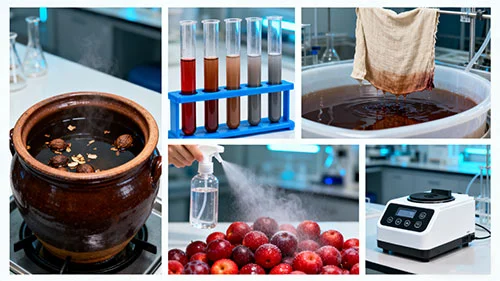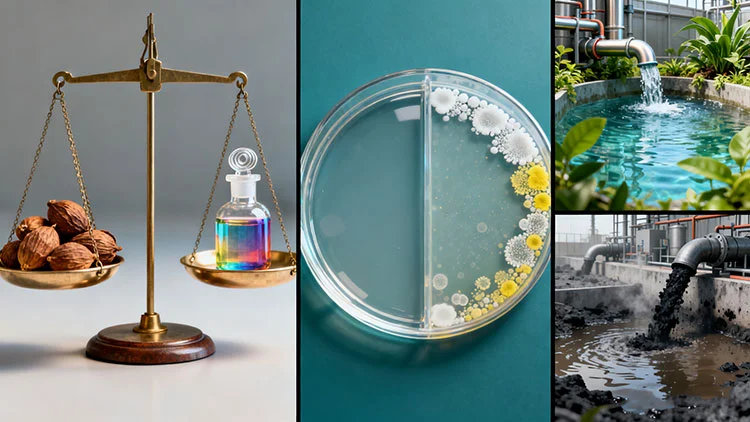Gallnut Extract as Multifunctional Natural Dye and Preservative
In the quest for sustainable and eco-friendly alternatives in various industries, gallnut extract has emerged as a versatile solution, offering dual functionality as both a natural dye and preservative. Derived from the galls formed on oak trees by certain insects, this extract is rich in tannins, particularly tannic acid, which imparts its unique properties. With growing concerns over synthetic additives and dyes, gallnut extract presents a promising option for food, textile, and cosmetic applications. Its ability to provide rich, warm color tones while simultaneously offering antimicrobial and antioxidant protection makes it an invaluable resource in the pursuit of natural, multifunctional ingredients. This blog explores the diverse applications and benefits of gallnut extract, highlighting its potential to revolutionize product formulations across multiple sectors.
Antimicrobial and Antioxidant Properties of Gallnut Extract in Food and Textiles
Natural Food Preservation
Gallnut extract has shown remarkable potential in natural food preservation, owing to its high content of tannic acid and other polyphenols. These compounds exhibit strong antimicrobial properties against a wide range of foodborne pathogens, including bacteria, yeasts, and molds. In various studies, gallnut extract has demonstrated efficacy in inhibiting the growth of Escherichia coli, Salmonella, and Listeria monocytogenes, among others. This natural preservative not only extends the shelf life of food products but also enhances their safety without the need for synthetic additives. Additionally, the antioxidant properties of gallnut extract help in preventing lipid oxidation in foods, maintaining their quality and nutritional value over time. This dual functionality makes gallnut extract an attractive option for food manufacturers looking to meet consumer demands for clean-label products.
Textile Protection
In the textile industry, gallnut extract offers a sustainable solution for fabric protection against microbial growth and degradation. When applied to textiles, the tannins in gallnut extract form strong bonds with fiber proteins, creating a protective barrier that resists bacterial and fungal colonization. This natural treatment is particularly beneficial for fabrics used in outdoor gear, sportswear, and medical textiles, where moisture management and hygiene are crucial. Furthermore, the antioxidant properties of gallnut extract contribute to the UV protection of fabrics, potentially extending their lifespan and maintaining color fastness. The use of gallnut extract in textile finishing not only imparts antimicrobial and antioxidant properties but also aligns with the growing trend towards eco-friendly and biodegradable textile treatments.
Synergistic Effects with Other Natural Compounds
Recent research has explored the synergistic effects of combining gallnut extract with other natural compounds to enhance its antimicrobial and antioxidant efficacy. For instance, blending gallnut extract with essential oils or other plant extracts has shown promising results in creating more potent natural preservatives for both food and textile applications. These combinations can offer broader spectrum protection against various microorganisms while potentially reducing the required concentration of individual components. In food applications, such synergistic formulations can address the challenge of off-flavors sometimes associated with high concentrations of gallnut extract alone. For textiles, these combinations can provide enhanced durability and wash resistance of the antimicrobial treatment, ensuring long-lasting protection.

Techniques for Applying Gallnut Extract as a Dual-Function Natural Dye
Extraction and Preparation Methods
The effectiveness of gallnut extract as a natural dye and preservative largely depends on the extraction and preparation methods employed. Traditional water-based extraction techniques involve simmering crushed gallnuts in water, which yields a solution rich in tannins. However, more advanced methods such as ultrasound-assisted extraction and supercritical fluid extraction have shown promise in increasing the yield and purity of the extract. These modern techniques not only improve efficiency but also allow for better control over the composition of the extract, tailoring it for specific applications. For use as a dye, the pH of the gallnut extract solution plays a crucial role in determining the final color. Acidic conditions typically produce warmer, reddish-brown hues, while alkaline conditions yield cooler, grayish tones. This versatility in color production makes gallnut extract an attractive option for natural dyeing in both textile and food industries.
Application Techniques in Textiles
In textile dyeing, gallnut extract can be applied through various methods, each offering unique benefits. The most common technique is immersion dyeing, where fabrics are soaked in a heated bath containing the extract. This method allows for deep penetration of the dye into fibers, resulting in rich, even coloration. For more localized or patterned applications, block printing or screen printing with gallnut extract-based dyes can be employed. These techniques not only impart color but also the inherent antimicrobial properties of the extract. To enhance color fastness and durability, mordants such as alum or iron salts are often used in conjunction with gallnut extract. These metal salts form complexes with the tannins, binding them more securely to the fabric. Additionally, recent innovations in microencapsulation technology have opened up new possibilities for applying gallnut extract to textiles, potentially offering controlled release of its preservative properties over time.
Food Coloring and Preservation Applications
In the food industry, gallnut extract serves the dual purpose of natural coloring and preservation. For liquid foods and beverages, direct incorporation of the extract is the simplest method. However, for solid or semi-solid foods, techniques such as spray drying or microencapsulation can be employed to create powdered forms of gallnut extract that are easier to incorporate and offer improved stability. When used as a food coloring agent, gallnut extract can impart a range of warm brown hues, making it suitable for products like baked goods, sauces, and beverages. Its application as a preservative often involves surface treatment, particularly for fresh produce and meats. Dipping or spraying solutions of gallnut extract can create a protective layer that inhibits microbial growth and oxidation. For processed foods, gallnut extract can be incorporated during the manufacturing process, providing both color and preservative effects throughout the product's shelf life.

Comparing Gallnut Extract with Synthetic Preservatives for Safety and Efficacy
Safety Profile and Regulatory Considerations
Gallnut extract, being a natural product, generally has a favorable safety profile compared to many synthetic preservatives. It is considered a Generally Recognized as Safe (GRAS) substance by the FDA when used in food applications. This natural origin and long history of use contribute to its acceptance among consumers seeking clean-label products. However, it's important to note that natural does not always equate to completely risk-free. Some individuals may experience allergic reactions or sensitivity to tannins. Regulatory bodies such as the European Food Safety Authority (EFSA) have conducted reviews on the safety of tannins, including those from gallnuts, and have established guidelines for their use in food products. In comparison, many synthetic preservatives, while effective, have faced scrutiny over potential long-term health effects. For instance, concerns have been raised about the impact of certain artificial preservatives on gut microbiota and their potential role in hyperactivity in children. The natural origin of gallnut extract positions it favorably in the current regulatory climate that increasingly favors natural alternatives.
Efficacy in Food Preservation
When comparing the efficacy of gallnut extract to synthetic preservatives, several factors come into play. Synthetic preservatives often offer more consistent and predictable results due to their standardized composition. They can be tailored for specific applications and typically require lower concentrations to achieve the desired preservative effect. Gallnut extract, while effective, may require higher concentrations to match the potency of synthetic alternatives in some applications. However, gallnut extract offers broader spectrum activity against various microorganisms due to its complex composition of tannins and other polyphenols. This natural complexity can make it more difficult for microorganisms to develop resistance, a growing concern with some synthetic preservatives. Additionally, the antioxidant properties of gallnut extract provide added benefits in preventing rancidity and maintaining food quality, something that many synthetic antimicrobial preservatives do not offer. In studies comparing gallnut extract to common synthetic preservatives like sodium benzoate or potassium sorbate, the natural extract has shown comparable efficacy in certain food systems, particularly in acidic conditions.
Environmental Impact and Sustainability
The environmental impact of preservatives is an increasingly important consideration in product formulation. Gallnut extract, being derived from a renewable natural resource, has a significantly lower environmental footprint compared to many synthetic preservatives. The production of gallnut extract typically involves less energy-intensive processes and fewer potentially harmful chemical inputs. Additionally, the biodegradability of gallnut extract means it poses less risk of environmental contamination after disposal. In contrast, some synthetic preservatives have been associated with environmental concerns, including their persistence in ecosystems and potential effects on aquatic life. The sustainability aspect extends to the textile industry as well, where gallnut extract offers an eco-friendly alternative to synthetic antimicrobial treatments that may contain heavy metals or other persistent chemicals. As industries strive to reduce their environmental impact, the use of natural preservatives like gallnut extract aligns well with sustainability goals and circular economy principles.
Conclusion
Gallnut extract stands out as a versatile and sustainable solution in the realms of natural dyeing and preservation. Its dual functionality offers significant advantages across food, textile, and cosmetic industries, providing antimicrobial protection and rich coloration while aligning with consumer demands for natural ingredients. As research continues to unveil its full potential, gallnut extract is poised to play an increasingly important role in developing safer, more environmentally friendly products. Its adoption represents a step towards more sustainable practices in manufacturing and food production, balancing efficacy with ecological responsibility.
For more information on gallnut extract and other natural plant extracts, please contact Shaanxi SCIGROUND Biotechnology Co., Ltd. at info@scigroundbio.com. As a leading manufacturer of plant extracts and health food ingredients, SCIGROUND is committed to providing high-quality, innovative solutions for various industries, leveraging our extensive experience and cutting-edge research capabilities.
FAQ
What is gallnut extract?
Gallnut extract is a natural substance derived from galls formed on oak trees, rich in tannins and used as both a dye and preservative in various industries.
Is gallnut extract safe for use in food products?
Yes, gallnut extract is generally considered safe and is recognized as GRAS (Generally Recognized as Safe) by the FDA for use in food applications.
How does gallnut extract compare to synthetic preservatives in terms of efficacy?
Gallnut extract offers broad-spectrum antimicrobial activity and antioxidant properties, often comparable to synthetic preservatives, especially in acidic conditions.
Can gallnut extract be used as a natural textile dye?
Yes, gallnut extract can be used as a natural dye for textiles, producing warm brown hues and offering additional antimicrobial benefits.
What are the environmental benefits of using gallnut extract?
Gallnut extract is derived from renewable resources, biodegradable, and has a lower environmental impact compared to many synthetic alternatives.
References
1. Zhang, J., Li, L., Kim, S. H., Hagerman, A. E., & Lü, J. (2009). Anti-cancer, anti-diabetic and other pharmacologic and biological activities of penta-galloyl-glucose. Pharmaceutical Research, 26(9), 2066-2080.
2. Arapitsas, P. (2012). Hydrolyzable tannin analysis in food. Food Chemistry, 135(3), 1708-1717.
3. Shirmohammadli, Y., Efhamisisi, D., & Pizzi, A. (2018). Tannins as a sustainable raw material for green chemistry: A review. Industrial Crops and Products, 126, 316-332.
4. Shahidi, F., & Ambigaipalan, P. (2015). Phenolics and polyphenolics in foods, beverages and spices: Antioxidant activity and health effects – A review. Journal of Functional Foods, 18, 820-897.
5. Kharchoufi, S., Licciardello, F., Siracusa, L., Muratore, G., Hamdi, M., & Restuccia, C. (2018). Antimicrobial and antioxidant features of 'Gabsi' pomegranate peel extracts. Industrial Crops and Products, 111, 345-352.
6. Prabhu, K. H., & Bhute, A. S. (2012). Plant based natural dyes and mordants: A Review. Journal of Natural Product and Plant Resources, 2(6), 649-664.